Understanding Foundry Sand Specifications
Foundry sand is a critical component in the metal casting industry, playing an essential role in producing high-quality castings. The specifications for foundry sand are crucial as they define the physical and chemical properties required for optimal performance in the casting process. This article delves into the fundamental aspects of foundry sand specifications, their importance, and how they influence the casting outcome.
What is Foundry Sand?
Foundry sand is a type of sand that is specially processed and tested to be used in the foundry industry. This sand is primarily silica, derived from high-purity quartz. Its granulation is consistent, enabling it to form a mold with superior strength, permeability, and reusability. The specific properties of foundry sand make it an ideal choice for producing molds and cores.
Key Specifications of Foundry Sand
1. Grain Size and Distribution The grain size is a critical factor in determining the mold's strength and permeability. Foundry sands typically have a grain size distribution that varies from fine to coarse. The most suitable grain size for mold making ranges between 0.15 mm and 0.60 mm. A well-graded sand allows for the optimal packing density, contributing to the mold's strength and its ability to hold fine detail.
2. Permeability Permeability refers to the ability of the sand mold to allow gases to escape during the pouring of molten metal. It is measured in Darcy or micrometers. A higher permeability is desirable, as it reduces the risk of defects such as burn-on or blow holes in the casting. The optimal permeability for foundry sands varies with the type of metal being cast, but it generally falls within the range of 30 to 150 cfm (cubic feet per minute).
foundry sand specifications

3. Moisture Content The moisture content of foundry sand affects its bonding characteristics and the mold's overall strength. Generally, the optimal moisture content should be around 2-5% for most sand types. Excess moisture can lead to steam formation during casting, resulting in defects, while too little moisture can make the sand too dry, causing the mold to break apart.
4. Fineness and Shape The shape of sand grains also contributes to the performance of the mold. Angular grains provide better interlocking capabilities, enhancing mold strength, while rounded grains are better for permeability. Typically, a mix of both shapes is used to balance the needs of strength and gas escape. Moreover, the fineness modulus of the sand helps in determining the overall quality, with lower numbers indicating finer sand.
5. Chemical Composition The chemical properties of foundry sand must also meet specific standards. Impurities such as clay, silt, and iron oxides can adversely affect the quality of the casting. Thus, the silica content should ideally be over 90%. The presence of contaminants could lead to alloy contamination, affecting the physical properties of the final product.
6. Reusability and Environmental Factors Foundry sand can often be reused multiple times before its properties significantly degrade. This not only reduces production costs but also minimizes environmental waste. Some specifications address the reclamation process, ensuring that spent sand can be processed to restore its original properties for reuse.
Conclusion
In summary, the specifications for foundry sand are foundational to the metal casting process. Attention to grain size, distribution, permeability, moisture content, chemical composition, and reusability ensures that foundries can produce high-quality castings with optimal structural integrity. As technology and methods evolve, adherence to these specifications will continue to be vital for quality assurance in foundry operations. For foundry operators, understanding and implementing these specifications are crucial for enhancing production efficiency and achieving consistent results in their casting endeavors. Properly specified foundry sand not only improves the quality of the product but also contributes to the sustainability of the casting process.
Post time:Out . 10, 2024 23:52
Next:sand casting description
